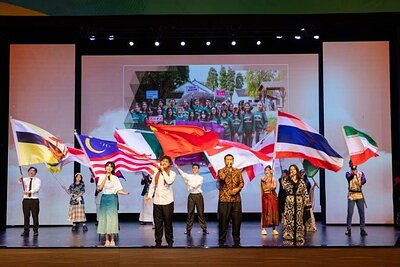
Bridging Cultures, Building Futures: Asian Youth Chart a Course for Sustainable Innovation
A new initiative in Nanjing is empowering a generation of Asian leaders to navigate a complex world, blending tradition, technology, and a commitment to sustainable development.
Bridging Cultures, Building Futures: Asian Youth Chart a Course for Sustainable Innovation
Nanjing, China – In a world increasingly defined by interconnectedness and rapid change, a new generation of Asian leaders is emerging, dedicated to fostering collaboration, innovation, and sustainable development. The inaugural “Dialogue with the Future for Asian Youth from Sister-cities,” held in Nanjing this past May, is a prime example of this growing movement, bringing together over 1,000 students from nearly 30 countries for a vibrant exchange of ideas and cultures.
Hosted by a consortium including Jiangsu Broadcasting Corporation, Jiangsu Association for the Development of International Communication at Colleges and Universities, and Nanjing University of Aeronautics and Astronautics, the event wasn't just a gathering; it was a deliberate attempt to cultivate a network of future leaders equipped to address the complex challenges facing the region. The initiative directly responds to a growing trend of youth exchange programs across Asia, supported by organizations like UNESCO and the IIE, and reflects a wider recognition of the critical role young people play in shaping a more peaceful and sustainable future.
“The goal wasn’t simply to discuss issues, but to forge genuine connections,” explains a representative from the organizing committee. “We wanted to create a space where students could learn from each other, share their perspectives, and build lasting relationships.”
Beyond Diplomacy: A Focus on Sustainable Innovation
The event’s theme, “New Asian Generation: Technology, Culture, and a Sustainable Future,” underscores a clear shift in focus. While traditional diplomatic efforts remain crucial, this initiative goes further, emphasizing the potential of technology and innovation to drive positive change. Keynote speakers from Nanjing University of Aeronautics and Astronautics and Shanghai International Studies University highlighted the intersection of artificial intelligence, brain science, and cultural understanding, urging students to harness technology responsibly while preserving their unique cultural heritage.
One participant, a student from Southeast Asia, noted, “It’s not enough to simply adopt new technologies. We need to consider the cultural context and ensure that innovation benefits all members of society.”
Beyond academic discourse, the event was a celebration of Asia’s rich cultural diversity. Students showcased their traditions through performances, food, and crafts, transforming the venue into a vibrant tapestry of cultures. This emphasis on cultural exchange isn’t merely symbolic. Research suggests that intercultural competence is a crucial skill for future leaders, enabling them to navigate complex global challenges and build effective partnerships.
Empowering a Generation of Media Envoys
A particularly noteworthy aspect of the “Dialogue with the Future” initiative is the certification of selected participants as “Asian Youth Media Envoys.” This program aims to empower young leaders to become effective communicators and storytellers, capable of bridging cultural divides and advocating for positive change.
“We believe that media literacy and communication skills are essential for the next generation,” explains Tracy Yang of JSBC. “By training these students to become media envoys, we’re equipping them with the tools they need to shape public discourse and promote understanding.”
Participants selected for the program underwent specialized training in areas such as digital storytelling, cross-cultural communication, and responsible journalism. They are now tasked with sharing their experiences and insights through various media platforms, reaching a wider audience and inspiring others.
Sister Cities: A Foundation for Regional Cooperation
The “Dialogue with the Future” event also highlights the growing importance of sister-city agreements in fostering regional cooperation. Many of the participating students came from cities with established ties to Nanjing, creating opportunities for sustained collaboration and knowledge exchange.
“Sister-city relationships provide a solid foundation for building trust and understanding,” explains a representative from Nanjing’s International Exchange Association. “By bringing students from these cities together, we’re strengthening these bonds and creating a network of future leaders who are committed to regional cooperation.”
However, some experts caution that sister-city programs aren’t without their challenges. “It’s important to ensure that these partnerships are equitable and mutually beneficial,” notes a regional analyst. “They shouldn’t simply be top-down initiatives; they need to involve local communities and address their specific needs.”
Looking Ahead: Sustaining the Momentum
The success of the inaugural “Dialogue with the Future” event raises the question of how to sustain the momentum and ensure that this initiative has a lasting impact. Organizers are already planning follow-up activities, including virtual exchange programs, collaborative research projects, and mentorship opportunities.
“We want to create a long-term ecosystem of support for these young leaders,” says a representative from Jiangsu Broadcasting Corporation. “We’re committed to providing them with the resources and opportunities they need to thrive.”
The initiative also points to a broader trend of youth-led movements driving positive change across Asia. From environmental activism to social entrepreneurship, young people are increasingly taking the lead in addressing the region’s most pressing challenges. The “Dialogue with the Future” event serves as a powerful reminder of the potential of this generation to shape a more sustainable, equitable, and prosperous future for all. One participant summed it up: “This wasn’t just a conference; it was a catalyst. We came here as students, but we’re leaving as changemakers.”
With continued support and investment, initiatives like the “Dialogue with the Future” can play a vital role in empowering a new generation of Asian leaders to navigate a complex world and build a brighter future for all.
